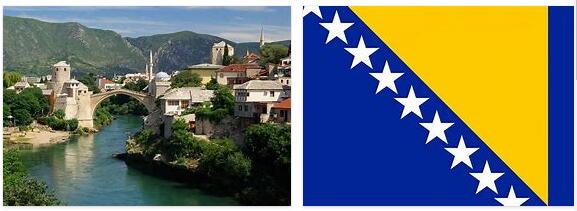Bosnia and Herzegovina Overview
Bosnia and Herzegovina, officially Bosnian, Serbian and Croatian Bosna i Hercegovina (BiH) [- hεrtsε-], state in Southeast Europe (2018) 3.3 million residents; The capital is Sarajevo.
In the south the country has a 20 km long stretch of coast to the Adriatic Sea.
Military
After the amalgamation of the sub-armies, the total strength of the armed forces of Bosnia and Herzegovina is 10,600 men. In place of compulsory military service, there has been a four-month general service obligation. The army (around 9,200 soldiers) is divided into 3 mechanized infantry brigades, 1 combat support brigade and 4 logistics battalions. The air force and air defense has around 900 men.
In 2006 Bosnia and Herzegovina joined NATO’s “Partnership for Peace”. US military aid to Bosnia and Herzegovina amounts to US $ 4 million (2015).
Education
There is general compulsory schooling between the ages of 6 and 15. The school system is divided into a nine-year primary level, which is followed by a structured system of four-year secondary schools. These lead to the (technical) Abitur and, in addition to grammar schools, include vocational secondary schools with different specialist areas (technical, commercial, medical, educational, artistic). The languages of instruction are in the Federation of Bosnia and Herzegovina, depending on the ethnic majority of the students, Bosnian or Croatian, in the Serb Republic of Serbian. This means that the school system is linguistically / ethnically split up, with ethnically integrated teaching only in the Brčko district. According to educationvv, the universities (standard period of study: 4 years) in Sarajevo (founded in 1949) form the basis of higher education, Mostar (founded in 1977), Tuzla (founded in 1976) and Bihać (founded in 1997) as well as around 40 higher education institutions, some of which are comparable to German universities of applied sciences (standard period of study: 2 years).
Media
The media landscape in Bosnia and Herzegovina is diverse, but primarily shaped by the ethnic division of the country. Governments and political parties are very influential.
Press: The most important daily newspapers are »Dnevni Avaz«, »Oslobodjenje« and »Jutarnje Novine« in Sarajevo, »Nezavisne Novine« and the government newspaper of the Serbian Republic »Glas Srpske« in Banja Luka as well as »Dnevni List« and »Večernji List« in Mostar. Also of importance are the independent political weekly newspapers “Slobodna Bosna”, “BH Dani” and “Start” (both in Sarajevo) and “Novi Reporter” (Banja Luka).
News agencies: Federalna Novinska Agencija (FENA, state) and Nezavisna Novinska Agencija (ONASA, private) in Sarajevo and Novinska Agencija Republike Srpske (SRNA, state) in Banja Luka.
Broadcasting: The public broadcasting system of Bosnia and Herzegovina is divided into three parts: Radio-Televizija Bosne i Hercegovine (BHRT, Sarajevo) broadcasts a radio (»BH Radio 1«) and a television program (»BHT 1«), »Radio- Televizija Federacije Bosne i Hercegovine “, RTV FBiH) two radio and television programs and” Radio Televizija Republike Srpske “(RTRS) one radio and one television program. Private TV channels include “NTV Hayat”, “OBN Televizija”, “Hema TV” (all Sarajevo) and the Serbian “BN TV”. There are also a large number of private radio stations; “Antena Sarajevo” and “RSG Radio” from the RSG Group are among the largest.
Tourism
South of Sarajevo is the formerly most important winter sports center of Yugoslavia (site of the XIV. Olympic Winter Games 1984), there are also some health resorts and spas with mineral and thermal springs, especially in the Bosnian highlands.
Bosnia and Herzegovina has tourist potential primarily due to its mountains with several national parks and old, historically interesting cities (Sarajevo, Mostar [ Mostar Bridge, destroyed in 1993; rebuilt in 2004; UNESCO World Heritage Site since 2005] and Jajce).
As a result of the war damage, the uncertain political framework and the sluggish investment in the tourist infrastructure, tourism in Bosnia and Herzegovina did not play a significant role for a long time. Only since the beginning of the 2000s has the number of holidaymakers increased significantly again (2013: 529,000 foreign visitors).
Transportation
The traffic grows big problems from the extremely complicated relief conditions (mountain ranges stretching from northwest to southeast). The routes of the traffic routes are connected with a large number of complex traffic structures. The only significant railway line of 601 km (with viaducts of a total of 8 km and tunnels of almost 40 km in length) runs through the Bosna and Neretva valleys and represents the most important traffic axis in the country; it opens the access to the navy lowlands on the one hand and to the Adriatic Sea (Croatian port of Ploče) on the other hand. The road network (22,900 km) is extensive and the roads are largely poorly developed. Sarajevo Airport is of international importance in air traffic; There are important regional airports in Tuzla, Banja Luka and Mostar.





